*NURSING > TEST BANK > Chapter 39_ Dressings, Bandages, and Binders _ Nursing School Test Banks Questions and Answers (All)
Chapter 39_ Dressings, Bandages, and Binders _ Nursing School Test Banks Questions and Answers
Document Content and Description Below
Chapter 39: Dressings, Bandages, and Binders MULTIPLE CHOICE 1. The nurse is caring for a patient who is bleeding. To control bleeding, she would apply a _____ dressing. a. pressure b. alginate c... . foam d. hydrocolloid ANS: A Apply a pressure dressing to control bleeding, but when wound drainage is present, use a highly absorbent dressing. Use an alginate, foam, or hydrocolloid dressing in a noninfected wound that is draining a moderate to large amount of exudate. DIF: Cognitive Level: Application REF: Text reference: p. 943 OBJ: Choose the correct dressing for a wound. TOP: Pressure Dressings KEY: Nursing Process Step: Implementation MSC: NCLEX: Physiological Integrity Students Chat Room 13 2/20/2017 Chapter 39: Dressings, Bandages, and Binders | Nursing School Test Banks https://nursingtestbank.info/chapter39dressingsbandagesandbinders/ 2/25 2. The nurse is changing a dry, woven gauze dressing when she notices that the gauze has inadvertently stuck to the wound. What should the nurse do? a. Pull the dressing off to aid in debridement. b. Recover the dressing and leave in place. c. Moisten the gauze to minimize trauma. d. Ensure that the shiny side of the dry gauze dressing does not stick. ANS: C When a dry dressing inadvertently adheres to the wound, moisten the dressing with sterile normal saline or sterile water before removing the gauze to minimize wound trauma. Moistening the gauze applies only to dry dressings and is not applicable for moisttodry dressings. A dry dressing is not used for debriding wounds. Telfa gauze dressings (not dry woven gauze dressings) contain a shiny, nonadherent surface on one side that does not stick to the wound. DIF: Cognitive Level: Application REF: Text reference: p. 946 OBJ: Understand the technique of a dressing, bandage, or binder application. TOP: Dry Woven Gauze Dressings KEY: Nursing Process Step: Implementation MSC: NCLEX: Physiological Integrity 3. The nurse is caring for a patient who has a wound healing by primary intention that has little to no drainage. Which dressing is most appropriate for this type of wound? a. Moisttodry dressing b. Hydrocolloid dressing Students Chat Room 13 2/20/2017 Chapter 39: Dressings, Bandages, and Binders | Nursing School Test Banks https://nursingtestbank.info/chapter39dressingsbandagesandbinders/ 3/25 c. Dry dressing d. Hydrogel dressing ANS: C Dry dressings are used for wound healing by primary intention with little drainage. These dressings protect the wound from injury, prevent the introduction of bacteria, reduce discomfort, and speed healing. The primary purpose of moisttodry dressings is to mechanically debride a wound. Hydrocolloid dressings provide a moist environment for wound healing while facilitating softening and subsequent removal of wound debris. Hydrogel dressings (e.g., Curasol, IntraSite Gel, Vigilon) have a high moisture content (95%), causing them to swell and retain fluid. They are useful over clean, moist, or macerated tissues. DIF: Cognitive Level: Analysis REF: Text reference: p. 946 OBJ: Choose the correct dressing for a wound. TOP: Dry Dressings KEY: Nursing Process Step: Assessment MSC: NCLEX: Physiological Integrity 4. The nurse would consider a dry dressing appropriate for a wound that requires which of the following? a. Protection b. Debridement c. Absorption of heavy exudate d. Healing by second intention ANS: A A dry dressing may be chosen for management of a wound healing by primary intention with little drainage. The dressing protects the wound from injury, reduces discomfort, and speeds healing. The dry Students Chat Room 13 2/20/2017 Chapter 39: Dressings, Bandages, and Binders | Nursing School Test Banks https://nursingtestbank.info/chapter39dressingsbandagesandbinders/ 4/25 dressing does not interact with wound tissues and causes little wound irritation. A dry dressing is not appropriate for an open wound that is healing by secondary intention. DIF: Cognitive Level: Application REF: Text reference: p. 946 OBJ: Choose the correct dressing for a wound. TOP: Dry Dressings KEY: Nursing Process Step: Planning MSC: NCLEX: Physiological Integrity 5. What should the nurse do for a patient who is having a wettodry dressing applied? a. Moisten the old inner dressing to remove it. b. Pack the gauze in flat pieces into the wound. c. Wet the new inner dressing with a cytotoxic solution. d. Apply a secondary dressing over the inner wet packing. ANS: D The primary purpose of wettodry dressings is to mechanically debride a wound. The moistened contact layer of the dressing (primary dressing) increases the absorptive ability of the dressing to collect exudate and wound debris. As the dressing dries, it adheres to the wound and debrides the wound of tissue when the dressing is removed. The moistened gauze must be covered with a secondary dressing layer that is dry. It is incorrect technique and a common error by some clinicians to moisten the dried gauze before removing it. This defeats the purpose of using this type of dressing and reduces the amount of debris that the dressing will remove. Open or “fluff” the woven gauze that will be placed directly against the wound bed. Moisten the packing material with a noncytotoxic solution such as normal saline. Never use cytotoxic solutions. DIF: Cognitive Level: Application REF: Text reference: p. 946 OBJ: Choose the correct dressing for a wound. TOP: WettoDry Dressings KEY: Nursing Process Step: Implementation Students Chat Room 13 2/20/2017 Chapter 39: Dressings, Bandages, and Binders | Nursing School Test Banks https://nursingtestbank.info/chapter39dressingsbandagesandbinders/ 5/25 MSC: NCLEX: Physiological Integrity 6. Moisttodry dressings consist of gauze moistened with an appropriate solution. What should the nurse do when caring for a patient who has a pressure wound that requires debridement? a. Saturate the primary dressing with saline or lactated Ringer’s solution. b. Moisten the primary dressing with saline or lactated Ringer’s solution. c. Moisten the primary dressing with acetic acid. d. Moisten the primary dressing with povidoneiodine. ANS: B Moisttodry dressings consist of gauze moistened with an appropriate solution. Commonly used wetting agents include normal saline and lactated Ringer’s solution, which are isotonic solutions that aid in mechanical debridement. A dressing that is too wet causes tissue maceration and bacterial growth. It also does not dry out and therefore does not remove necrotic tissue when it is being removed from the wound. Acetic acid is effective against Pseudomonas aeruginosa but is toxic to fibroblasts in standard dilutions. Povidoneiodine is a rapidacting antimicrobial agent for cleansing intact skin and is never used on a healthy granulating wound bed. DIF: Cognitive Level: Application REF: Text reference: p. 946 OBJ: Choose the correct dressing for a wound. TOP: WettoDry Dressings KEY: Nursing Process Step: Assessment MSC: NCLEX: Physiological Integrity 7. The patient has a large, deep wound on the sacral region. The nurse correctly packs the wound by: a. filling two thirds of the wound cavity. b. leaving salinesoaked folded gauze squares in place. Students Chat Room 13 2/20/2017 Chapter 39: Dressings, Bandages, and Binders | Nursing School Test Banks https://nursingtestbank.info/chapter39dressingsbandagesandbinders/ 6/25 c. putting the dressing in very tightly. d. extending only to the upper edge of the wound. ANS: D Apply moist, finemesh, openweave gauze as a single layer directly onto the wound surface. If the wound is deep, gently pack the gauze into the wound with a sterile gloved hand or forceps until all wound surfaces are in contact with the moist gauze. Be sure that the gauze does not touch periwound skin. Moisture that escapes the dressing often macerates the periwound area. The gauze should be saturated with the prescribed solution, wrung out, unfolded, and lightly packed into the wound. Overpacking the wound may cause pressure on tissue in the wound bed. DIF: Cognitive Level: Application REF: Text reference: p. 950 OBJ: Apply dry, moisttodry, pressure, transparent, and synthetic dressings correctly. TOP: Packing the Wound KEY: Nursing Process Step: Implementation MSC: NCLEX: Physiological Integrity 8. What should the nurse do for a patient with a sudden severe hemorrhage? a. Go for help. b. Drape the patient. c. Apply direct pressure. d. Put on clean or sterile gloves. ANS: C Students Chat Room 13 2/20/2017 Chapter 39: Dressings, Bandages, and Binders | Nursing School Test Banks https://nursingtestbank.info/chapter39dressingsbandagesandbinders/ 7/25 Apply direct pressure immediately. Seek assistance after pressure is applied. Maintaining asepsis and privacy is considered only if time and severity of blood loss permit inclusion of these activities. DIF: Cognitive Level: Application REF: Text reference: p. 953 OBJ: Choose the correct dressing for a wound. TOP: Hemostasis KEY: Nursing Process Step: Implementation MSC: NCLEX: Physiological Integrity 9. What should the nurse anticipate might happen to a patient if bleeding cannot be controlled? a. Skin dryness b. Bradycardia c. Hypovolemic shock d. Hypertension ANS: C Findings of tachycardia, hypotension, diaphoresis, restlessness, and diminished urinary output indicate impending hypovolemic shock. Bradycardia is a decreased pulse rate. Dry skin is not an indicator of hypovolemic shock. Hypertension is an increase in blood pressure. DIF: Cognitive Level: Application REF: Text reference: p. 955 OBJ: Assess a wound correctly. TOP: Hypovolemic Shock KEY: Nursing Process Step: Assessment MSC: NCLEX: Physiological Integrity 10. How should the nurse proceed when applying a pressure bandage? a. Elevate the extremity or area of bleeding. Students Chat Room 13 2/20/2017 Chapter 39: Dressings, Bandages, and Binders | Nursing School Test Banks https://nursingtestbank.info/chapter39dressingsbandagesandbinders/ 8/25 b. Wrap pressurebandage gauze in a proximaltodistal direction. c. Apply pressure to diminish the pulse to the distal body part. d. Wrap tape around the circumference of the site to secure the gauze padding. ANS: A As soon as possible, elevate the extremity or area of bleeding. Elevation assists in decreasing the rate of blood loss. Start the pressure bandage from distal to proximal, working toward the heart. Secure tape on the distal end, pull tape across the dressing, and maintain firm pressure as the proximate end of the tape is secured. To ensure blood flow to distal tissues and to prevent a tourniquet effect, adhesive tape must not be continued around the entire extremity. DIF: Cognitive Level: Application REF: Text reference: p. 954 OBJ: Understand the technique of a dressing, bandage, or binder application. TOP: Pressure Bandage KEY: Nursing Process Step: Implementation MSC: NCLEX: Physiological Integrity 11. Serious hemorrhaging has resulted in the patient experiencing a fluid and electrolyte imbalance. How should the nurse respond? a. Initiate intravenous (IV) therapy. b. Order blood for transfusions. c. Remove and reapply any dressings. d. Monitor vital signs every 15 minutes [Show More]
Last updated: 1 year ago
Preview 1 out of 25 pages
Instant download
.png)
Buy this document to get the full access instantly
Instant Download Access after purchase
Add to cartInstant download
Reviews( 0 )
Document information
Connected school, study & course
About the document
Uploaded On
Sep 09, 2021
Number of pages
25
Written in
Additional information
This document has been written for:
Uploaded
Sep 09, 2021
Downloads
0
Views
47

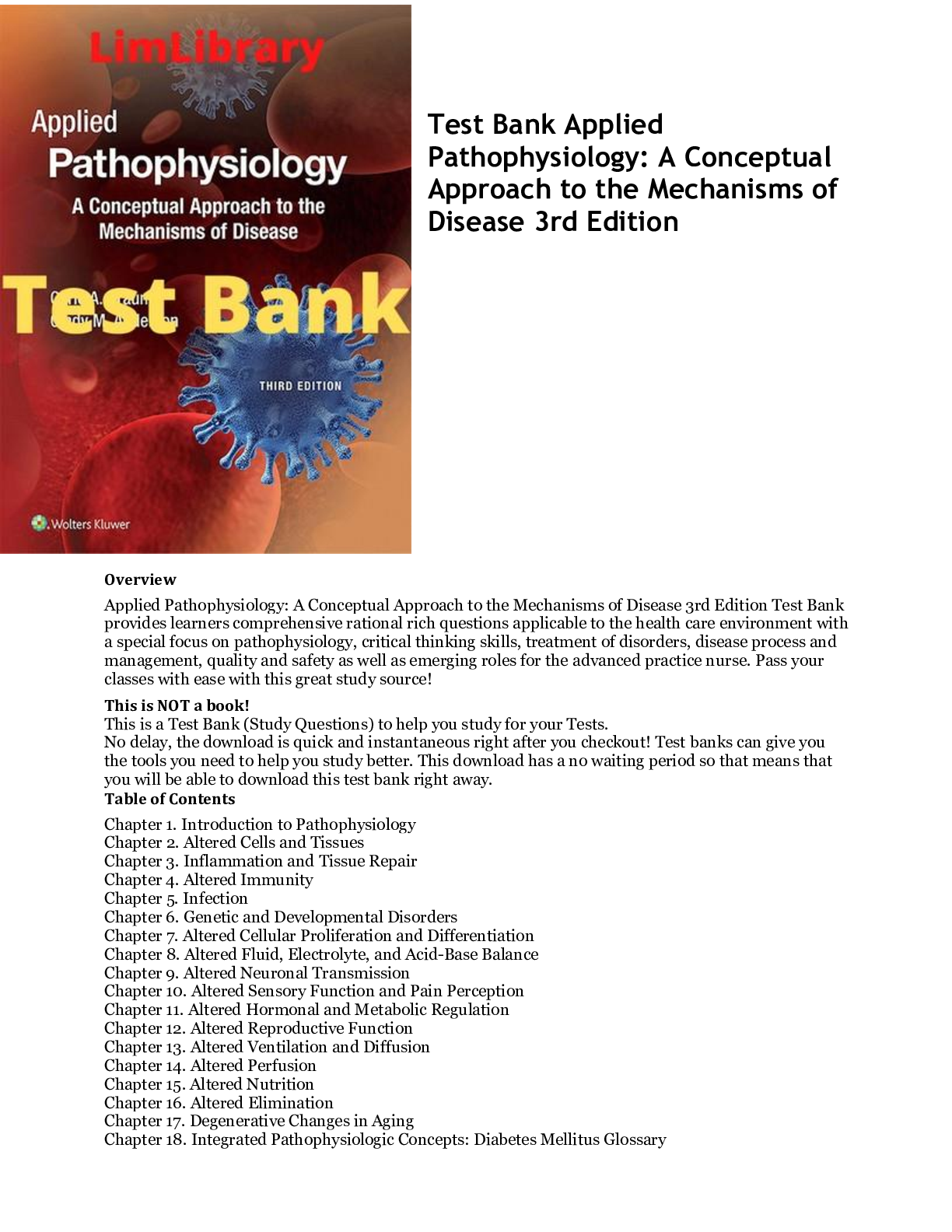

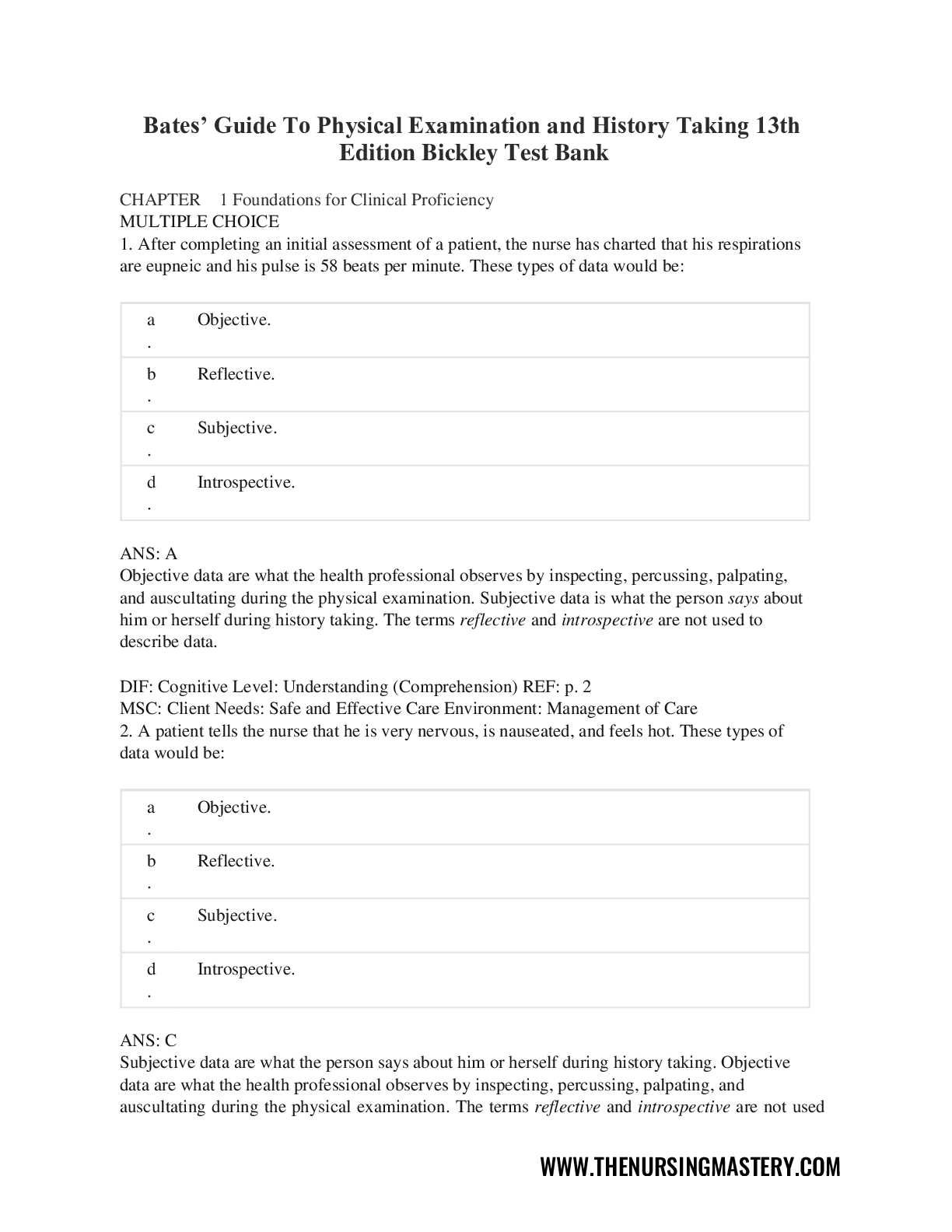
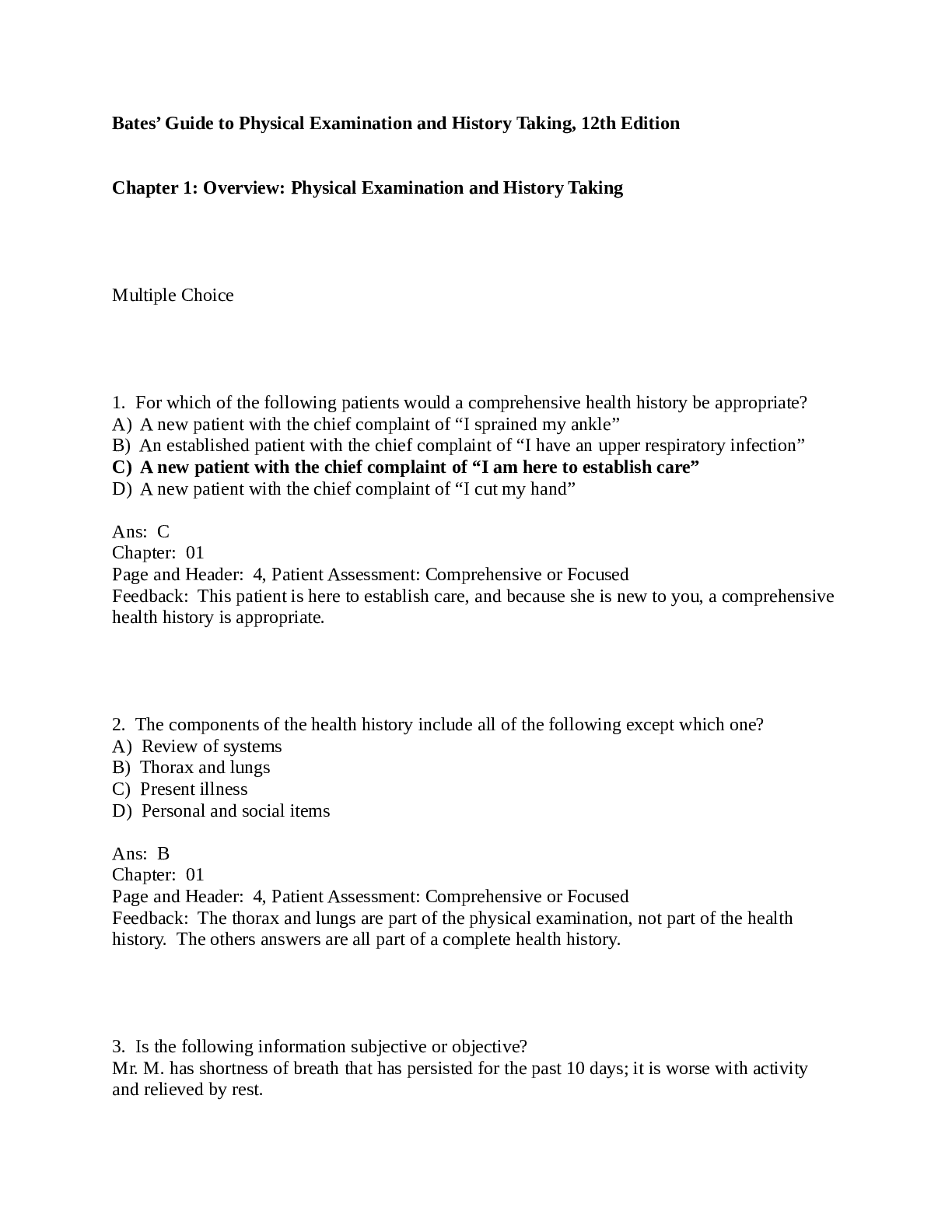
.png)
.png)
.png)

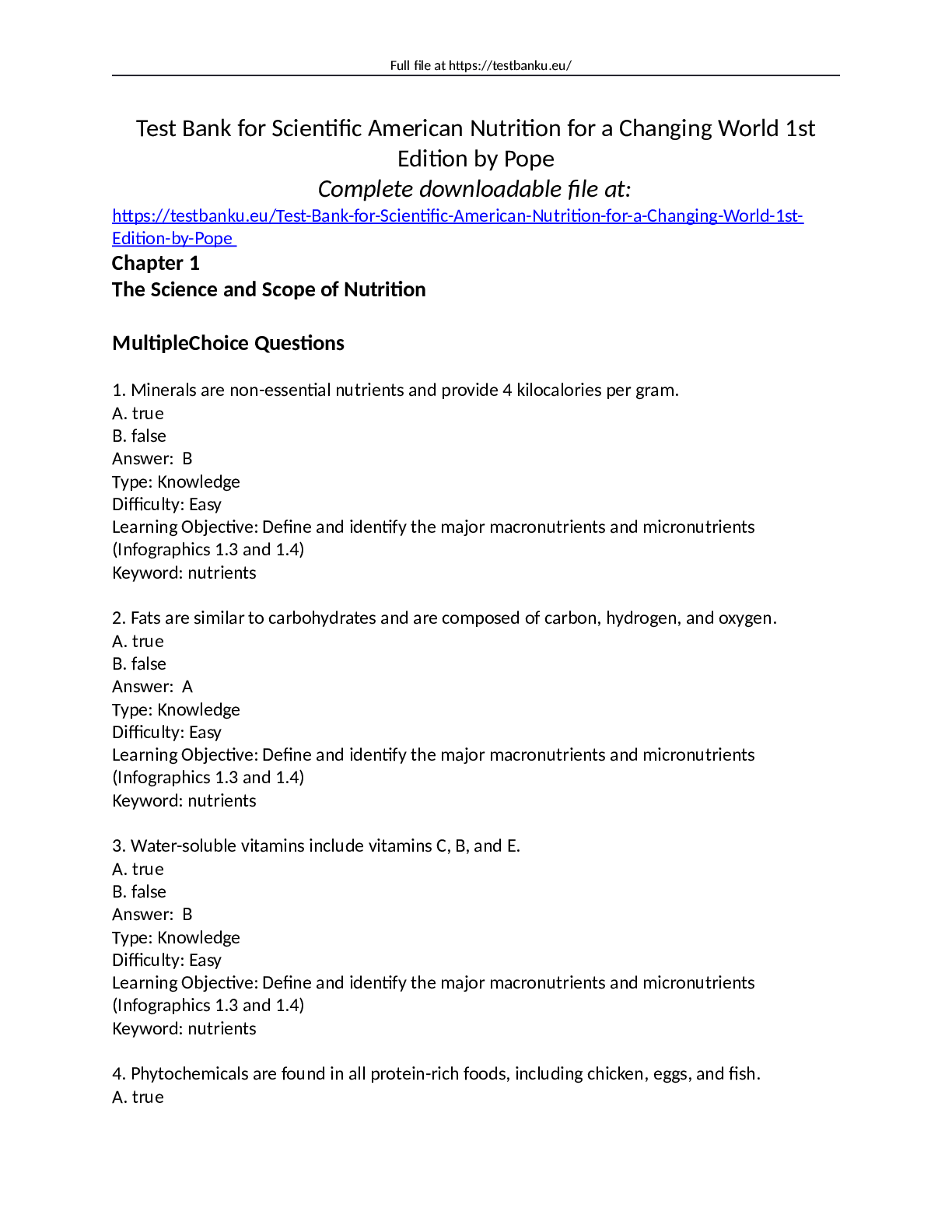
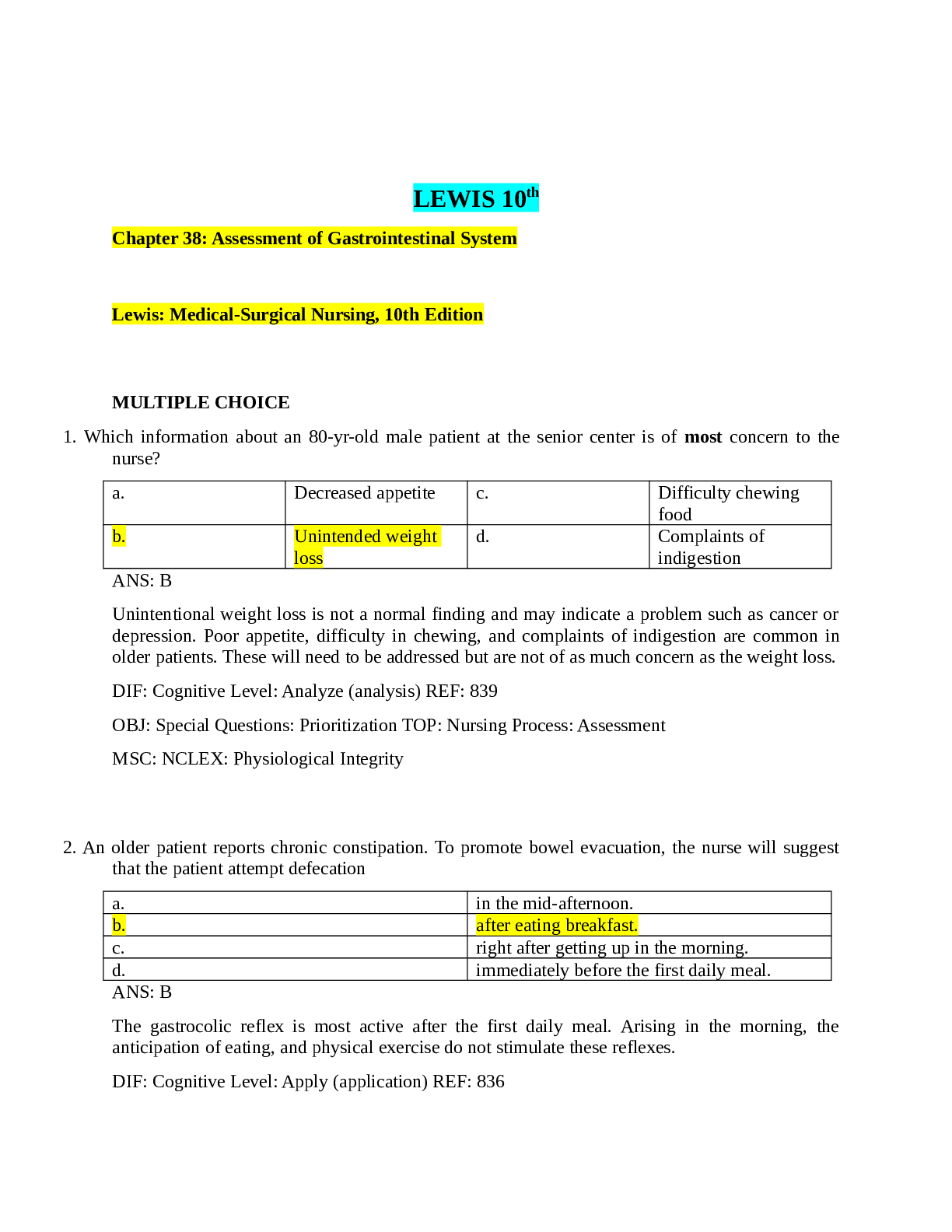

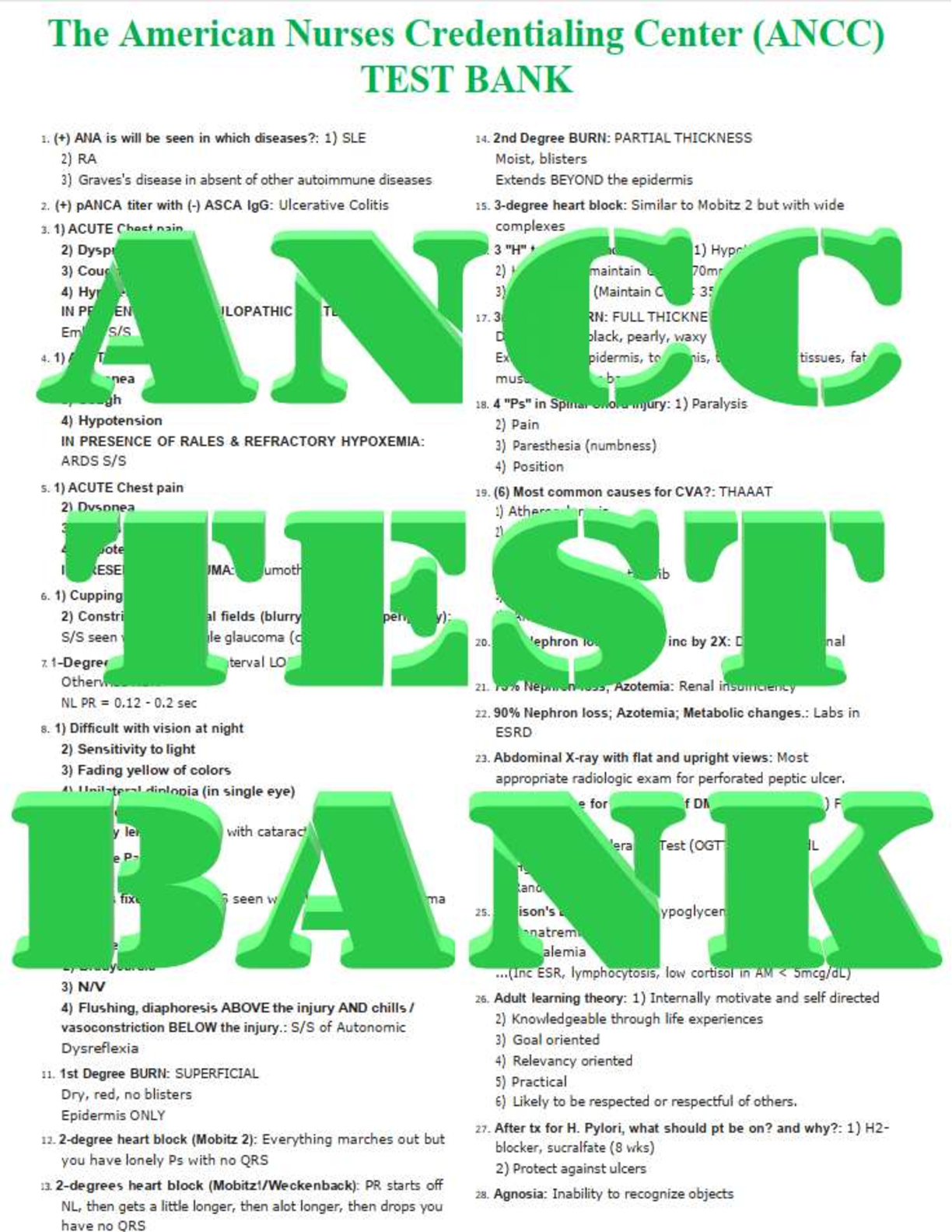
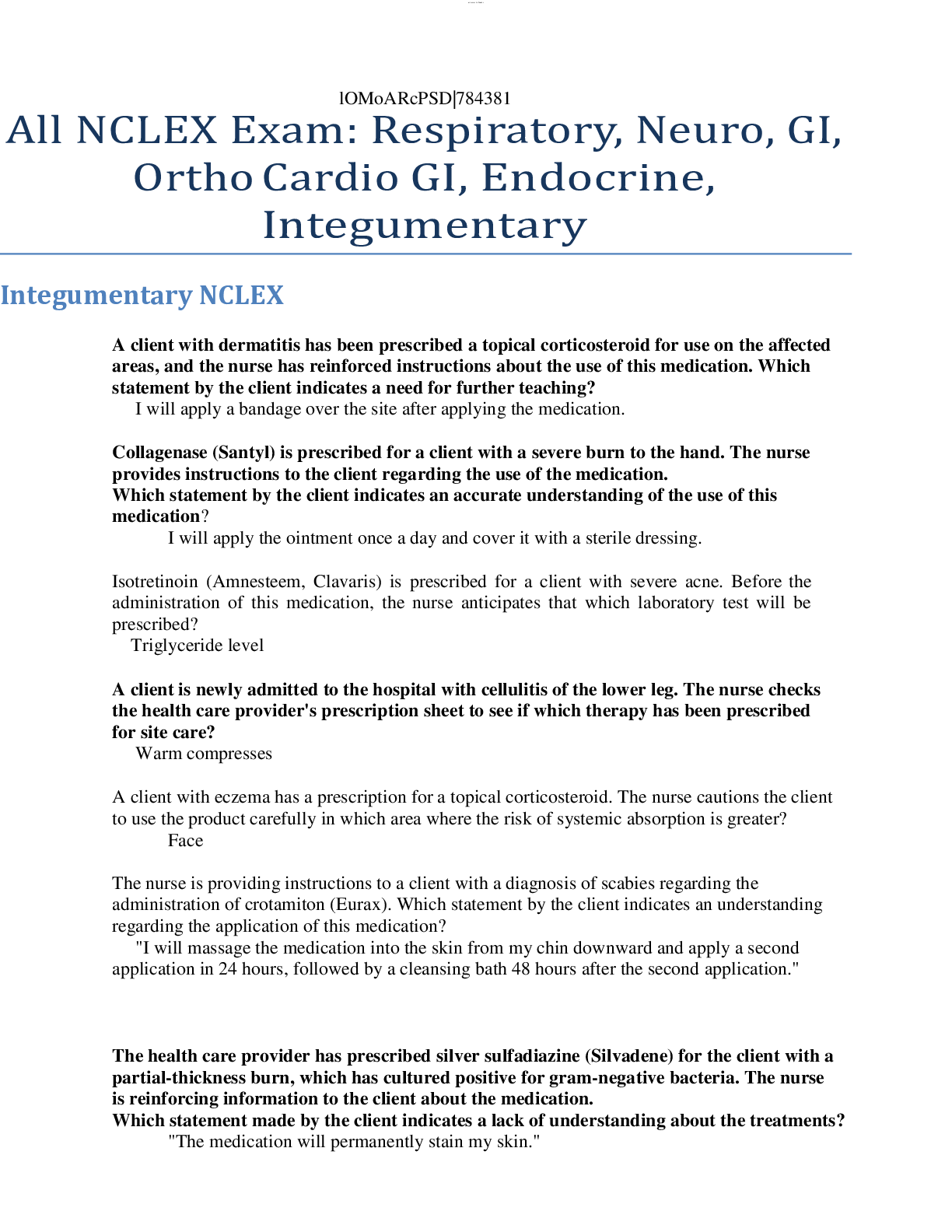




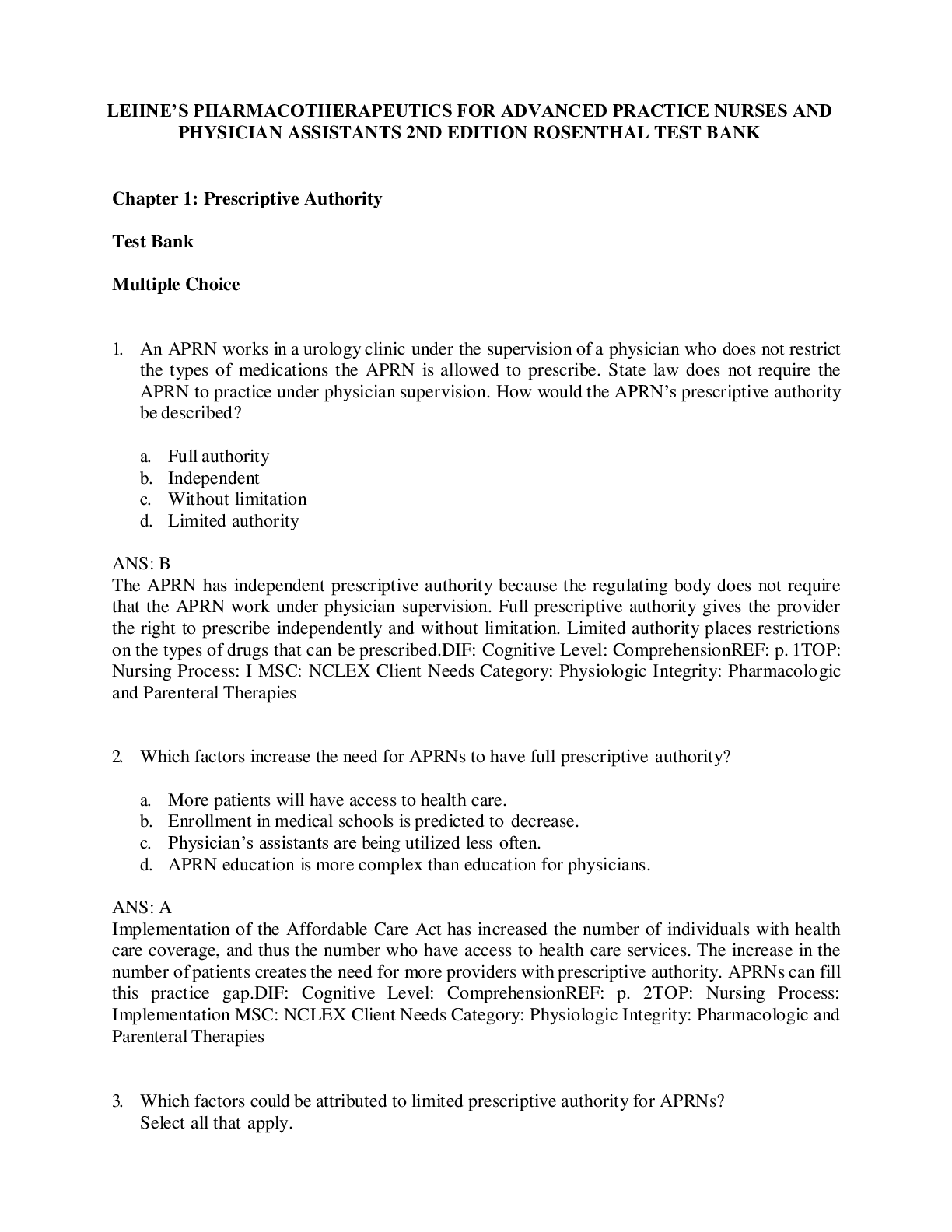
.png)


.png)

